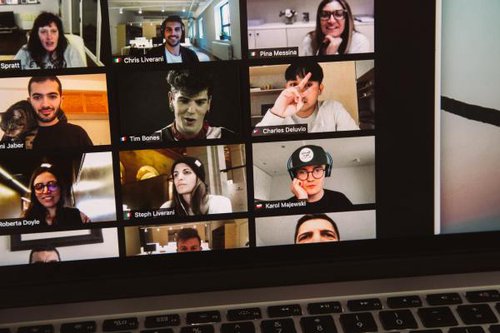
Remote working best practices – Uptree’s reflections on online student engagement
A key focus for the Uptree Team is on the quality of our online events - we are constantly thinking about the student experience and online working practices. This involves both co-creating first-class content with our partners but also thinking about how our events look and feel.
Being several months into a ‘new normal’, we wanted to share some of our learnings on interacting with students online, and some practical advice on how to get the most out of students during an online work experience day.

Firstly, video calls are not like in-person interactions. A key benefit of online events is that students can join from further afield, and whilst most of us now think of ourselves as Zoom ‘power users’, many of our students will not. In fact, they might be dialling in from with unreliable Wi-Fi connection or mobile phone and it’s likely they will be entering the call without knowing any of their peers. For somebody brand new to the field and only just starting to think about the word ‘career’, this can be really daunting stuff.

Then there’s icebreakers. Online, there is less space for improvisation. Whereas in person you might rely on jokes and wit to make students feel more comfortable.
For online icebreakers, you have to be more deliberate, scripted and clear.
It’s not to say it’s harder but it’s definitely different. You need to do more to build confidence among groups of students, particularly when asking for interactions via cameras and microphones.
It’s the little things that boost confidence amongst your audience that leads to great student engagement.
How to prep your volunteers
· At a work experience session, the world of industry and schools collide. Many of your volunteers will not have worked with young people before. So, it’s worth taking the time to brief everyone, setting roles and managing expectations.
· Remind your volunteers that they will need to actively chair a session as much as the students, introductions and repeating simple instructions are a great way to make young people feel more at ease.
· It’s also harder for students to make a good first impression online, so remind your volunteers of this. No cameras on doesn’t necessarily mean no engagement and online events with young people are likely to be less polished than your average work meeting.
· Ask your volunteers to thank students. Whilst this might seem a little strange or over the top in the professional world, demonstrating you are pleased with a student’s answer is a way of positively affirming the need for interaction on the call. It will encourage others, who are perhaps shyer, to ask you questions too.
How to host
If you were at an event, you would naturally have a low-level type of interaction with students and volunteers in the same room. It’s one of the most powerful benefits of in-person work experience. But for some reason, when we are online, we have a tendency to become rather awkward! As if the only way to start a call is with a technical check and a robotic ‘Ok, we are going to start now’.
Online icebreakers
Quizzes work really well to get students interacting together or chairing a ‘Which city are you from?’ question before launching a collaborative task also works well. By doing this, you will automatically demonstrate to the students that this will be an active learning experience, not a passive one.
Your (virtual) background
Remember that online, people will always obsess over what’s in your background, so as a host you can make this work to your advantage. Having a fun ‘Zoom’ background can set the tone for an online meeting, depending on your role and objectives. Changing backgrounds and names can also help students to distinguish quickly between teams or departments if there’s multiple on a call.
Technical difficulties
If you’re experiencing technical difficulties, don’t dwell on it. It opens the call for critique and disengagement and can set things off on the wrong foot. If things do go wrong, be open and honest, then move on.
Presentation manner
By asking simple questions and chairing in a confident yet natural way, you will start to see your students settle into the session and everybody will get more out of it as a result. You might even find they begin to support each other, as is another key benefit of online events.
Conclusion
We have incorporated this training into our own instructions online; much of the advice is applicable whether you are hosting a meeting, conference, or work experience day. The key is to remain calm, upbeat and prepped, and to make life as easy as possible for everyone on the day.
We look forward to working with you in the new academic year!
By Uptree
Published on:
Fri 7 Aug 2020